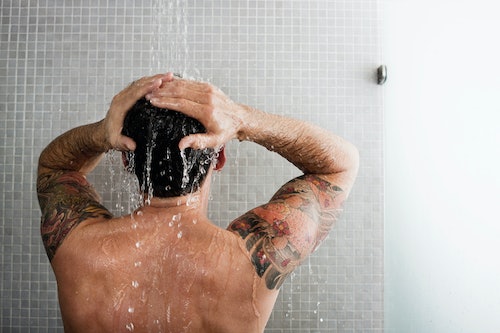The Only Change You Need To Make On January 1st
— Robin Skjoldborg/Image Source/Getty Images
One of the great indulgences of the 2023 holiday season — right alongside Christmas cookies, eggnog, and all-day sweatpants — is daydreaming about the person you’ll become in 2024. That fitter, better, calmer, cooler you. You know, the real you. But setting ourselves up to fail with unachievable or resoundingly vague New Year’s resolutions (get fit! lose weight! become happier!) is as much a part of the annual tradition as fireworks and sparklers.
There is, however, one ultra-simple change you can make — it’s really just the turn of a knob — any day of the year that can both radically shift your outlook in the short term and improve your well-being in the long term: Take the cold plunge. But you don’t have to leap into the Atlantic on New Year’s Day, do laps in Puget Sound in February, or invest in a pricey ice bath to reap the benefits of cold water therapy. It can be as simple as taking a shower, and even James Bond does it.
The Science of the Cold Plunge
While people have been living and swearing by the cold plunge for millennia, scientific research into the benefits into benefits of cold water is just starting to emerge. What research is out there is thin, but it’s good news — though we don’t yet fully understand the why, we do know that immersion in cold water can help with blood glucose regulation, inflammation and immune response, mental health, and managing stress.
Proponents of the icy plunge, such as cold water biohacking pioneer Wim Hof, say the process is life-changing. Hof, who has held Guinness World Records for cold exposure, claims that when combined with certain breathing techniques, cold water submersion “starts a cascade of health benefits, including the buildup of brown adipose tissue and resultant fat loss, reduced inflammation that facilitates a fortified immune system, balanced hormone levels, improved sleep quality, and the production of endorphins,” according to his website.
According to Hof, because ancient humans were constantly exposed to cold, our ancestors were stronger, more supple, and had sharper minds, and now because many of us live in relative comfort — climate-controlled homes and offices — and don’t need to be on constant alert for predators and other dangers, we are less resilient, more prone to stress and injury, and lack energy and focus. But it’s not about giving up modern comforts, for those of us lucky enough to enjoy them, it’s more about waking up our senses and connecting mind and body.
Hof isn’t just some quack: One study from the Netherlands of 3,000 people found that people who took cold showers for 30 to 90 seconds per day missed 30% fewer days of work due to illness. Another review study published in 2022 found that ice baths might cut that ‘bad’ fat Hof is talking about in men and decrease the risk of diabetes. There are also theories, covered in Fatherly, that the cold plunge (taken via ice bath) helps recovery after a grueling workout — good news if you’re looking to hit two resolutions in one, or if fitness is already a part of your routine. Other research has found that getting so cold you shiver makes the practice the most effective — and that the practice may help insulin sensitivity more than exercise itself, NPR reports.
The Practice of the Cold Plunge
How do you get started? You definitely don’t need to stand in an icy shower for 20 minutes. In fact, it’s best you don’t.
The best way to adopt cold therapy is to go slowly. Start by turning the temperature from warm to cold near the end of your shower, and stay under the stream for 30 seconds, something you can gradually build up to doing daily. If you work out regularly, some experts recommend reserving cold therapy for cardio or rest days only. Experts recommend immersing yourself in water that’s between 50-60 degrees, which is in range with most cold showers. (Though some serious cold plungers go as low as 38 degrees, Forbes Health reports.)
You can increase your exposure time as you grow more accustomed to the practice — once you’ve mastered 30 seconds, stretch yourself to a minute, then two or three. Focus on your breathing. It will never be physically comfortable — the body will always react to the cold — but the mind adjusts in powerful ways. (Regular practitioners report being “addicted” to a quick, cold shower every morning.)
Starting slowly is key. Obviously, extended exposure to cold increases your risk of hypothermia, so don’t stay in a cold shower for more than 15 minutes or so. And older adults, as well as those with cardiovascular concerns or hypertension, should avoid cold therapy. Talking to a doctor before you make the lifestyle change is also always a good bet.


